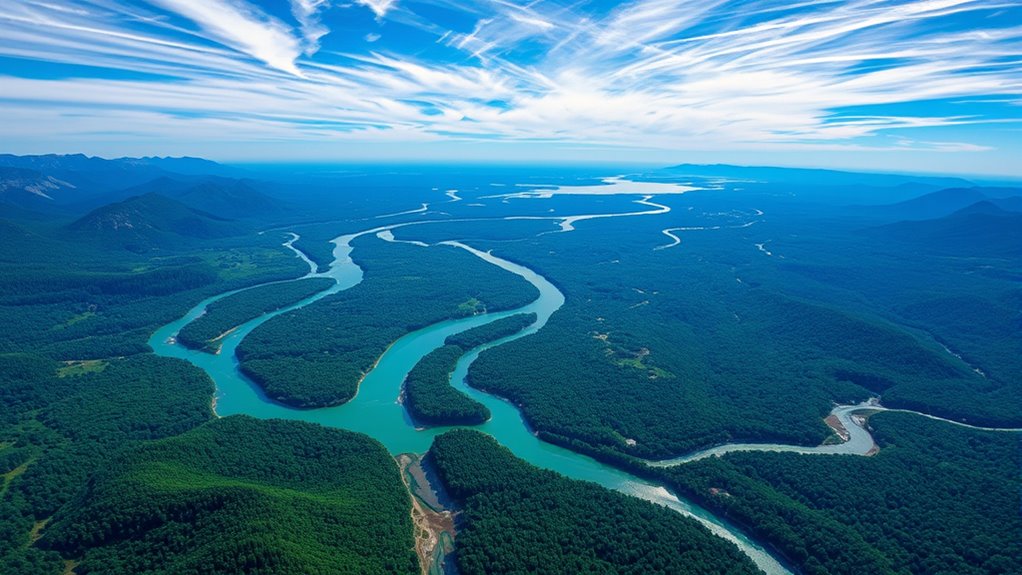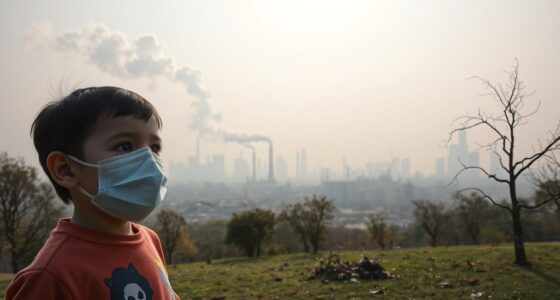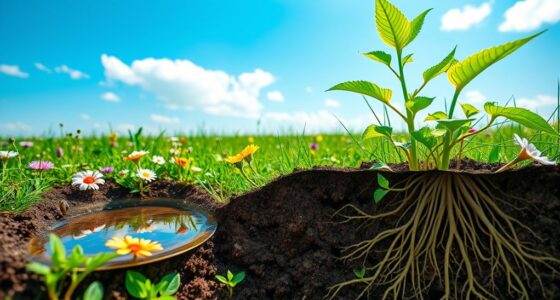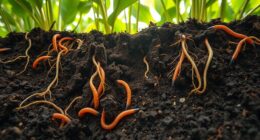Watersheds are areas where rainwater and melting snow drain into the same waterbody, shaping water quality and flow. They’re crucial for managing pollution, preventing floods, and protecting ecosystems. Human activities like farming and urbanization can introduce pollutants, so proper management—such as planting buffers and controlling runoff—is essential. By understanding how watersheds work, you can see why caring for these areas helps keep our water clean and healthy. Learn more about how you can make a difference.
Key Takeaways
- Watersheds are land areas that drain rainwater and snowmelt into a common waterbody, shaping water flow and quality.
- They are vital for managing water resources, controlling pollution, preventing floods, and protecting aquatic ecosystems.
- Human activities like farming and urbanization can introduce pollutants, impacting water quality within watersheds.
- Effective watershed management includes controlling runoff, planting buffers, and promoting conservation efforts.
- Proper care ensures cleaner water, reduces flooding, supports wildlife, and sustains water resources for future generations.

Have you ever wondered where the water in your local river or stream begins? It all starts in a watershed, the land area that drains rainwater and melting snow into a common waterbody. Watersheds are the foundation of our water systems, shaping how water flows and how clean or polluted it becomes. Understanding how watersheds work is essential, especially when it comes to managing water quality and protecting aquatic ecosystems. Effective watershed management involves coordinating efforts across communities, landowners, and government agencies to preserve water resources. When everyone works together, it’s easier to control pollution, prevent flooding, and maintain healthy water flows.
Water quality within a watershed depends on both natural processes and human activities. Pollution from farms, factories, and urban areas can wash into streams and rivers during rainfall, degrading water quality. That’s why proper watershed management is indispensable. It includes strategies like controlling runoff, planting buffers along waterways, and regulating land use to minimize pollutants entering the water. These practices help keep water clean, safe for drinking, recreation, and supporting wildlife. By maintaining good water quality, we also protect aquatic habitats, ensuring fish and other species thrive.
Pollution from farms, factories, and urban areas can degrade water quality during rainfall.
When you think about watershed management, it’s useful to realize that it’s not just about water. It’s about land use planning, conservation, and community involvement. For example, preventing deforestation and promoting sustainable farming can reduce sediment and nutrient loads in water bodies. Installing green infrastructure like rain gardens and permeable pavements helps absorb runoff, reducing the amount of pollutants reaching streams. Public education also plays an important role, encouraging people to dispose of waste properly and use fewer chemicals. All these efforts contribute to healthier watersheds, which in turn support better water quality. Additionally, understanding the role of watersheds in water systems helps us appreciate how interconnected our environment truly is.
You can have a direct impact by supporting local initiatives that focus on watershed preservation. Participating in cleanup events or advocating for policies that protect natural landscapes helps safeguard water sources. When watersheds are well-managed, they provide cleaner water, reduce flooding risks, and support recreational activities that enrich communities. Remember, the health of your local water bodies depends on how well the entire watershed is cared for. Small actions, like planting native vegetation or reducing pesticide use, add up over time. By understanding how watersheds function and why they matter, you become part of a critical effort to sustain our water resources for generations to come.
Frequently Asked Questions
How Do Human Activities Impact Watershed Health?
Human activities impact watershed health crucially. When you contribute to urban runoff, pollutants like oil, chemicals, and trash wash into water systems, harming ecosystems. Deforestation removes essential plant cover, increasing erosion and sediment in water. These actions disrupt natural processes, degrade water quality, and threaten wildlife. By reducing urban runoff and practicing sustainable land use, you can help protect and restore watershed health, ensuring clean water for everyone.
What Are the Best Ways to Protect Watersheds Locally?
You can protect watersheds locally by getting involved in community efforts like cleanup events and advocacy. Support land conservation initiatives to preserve natural habitats and reduce runoff pollution. Educate others about the importance of healthy watersheds and advocate for policies that protect water quality. Remember, your active participation and support for conservation help maintain clean water sources and resilient ecosystems for everyone in your community.
How Do Watersheds Affect Agricultural Practices?
Think of a watershed as nature’s delicate balancing act, shaping how you farm. It influences your practices by controlling soil erosion and nutrient runoff. When you over-apply fertilizer or neglect cover crops, you risk polluting water sources downstream. Respecting watershed boundaries helps you implement sustainable methods, reducing erosion and runoff. By working with the land’s natural flow, you protect both your crops and the environment, ensuring healthy, productive fields for years to come.
Can Watersheds Recover From Pollution?
Yes, watersheds can recover from pollution, but it takes time and effort. Your role in pollution mitigation boosts watershed resilience, helping ecosystems bounce back. Implementing best practices like reducing runoff, controlling pesticides, and restoring natural vegetation strengthens the watershed’s ability to heal. Active pollution management and community involvement are key. With patience and proper care, you can help restore watersheds to healthier, more resilient states.
What Role Do Watersheds Play in Climate Change?
Imagine your watershed as a sturdy shield, fighting against climate change’s storms. It plays a crucial role by maintaining watershed resilience, absorbing excess rainfall, and filtering pollutants. As climate patterns shift, healthy watersheds support climate adaptation, helping ecosystems and communities withstand droughts or floods. You can protect this natural buffer by conserving land and reducing pollution, ensuring your watershed continues to serve as a resilient defender against climate impacts.
Conclusion
Understanding watersheds is like holding the blueprint to Earth’s most precious treasure—the water we rely on every day. By protecting and caring for these essential systems, you become a hero in ensuring clean water for generations to come. Remember, a single healthy watershed can make a difference bigger than you can imagine—it’s the heartbeat of our planet’s health. So, stay vigilant and do your part; the future of water depends on it!










